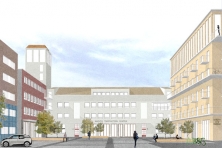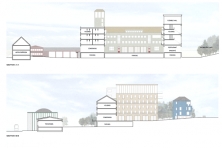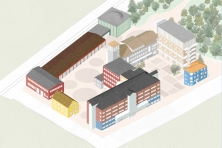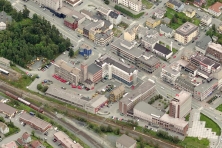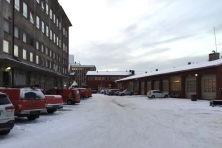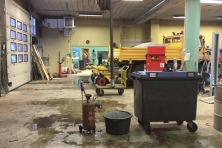On Reflection
Narvik (NO) - Lauréat
DONNÉES DE L’ÉQUIPE
Représentant d’équipe : Martin Berg (SE) – architecte
Associée: Matilda Schuman (SE) – architecte
Schuman Berg Arkitektkontor - Trollesundsvägen 100, 124 57 Bandhagen (SE)
+4670-676 25 11 – info@schumanberg.se – schumanberg.se
Voir la liste complète des portraits ici
Voir la page du site en anglais ici

M. Berg et M. Schuman
INTERVIEW en anglais
Cliquer sur les images pour les agrandir
1. How did you form the team for the competition?
We met at the School of Architecture at the Royal Institute of Technology in Stockholm. We assisted each other with our separate diploma projects but we have never worked together on a common project. We thought of Europan as a suitable competition to do together, as a way to explore our mutual interests within the field of architecture.
2. How do you define the main issue of your project, and how did you answer on this session main topic: the place of productive activities within the city?
One of the main issues of the project was to find plausible strategies for transforming existing buildings into a new use. As stated clearly in the brief, the city wanted to invest in knowledge-based companies started by young people living in Narvik. It was important to us to find pragmatic answers and to be realistic about the economic aspect – it is cheaper to convert an existing building than building something new, and cheap rentable space is what a start-up company needs. But we also believe that keeping existing buildings can have other positive aspects, such as supporting a local character. When demolishing and building something new, the uniqueness of a place easily gets lost. It also shifts the focus from a local to an international level, because today architecture tends to be a global phenomenon where everything looks the same, no matter where it is built. We also think it is important to reflect on how production and innovation happen and can be encouraged. At a larger scale, we think that urbanity and a pulse created by a multi-functional environment is important. But moments of inspiration, rest, creative thinking and informal meetings can happen everywhere – in your home, the laundry room or the common hallway. The whole quarter can have a great influence on creativity – not only the specific workplace.
3. How did this issue and the questions raised by the site mutation meet?
The location of the Technical Quarter has great potential to host the new urban arena for the young in Narvik. It is centrally located in the city, where a renewal of the town centre is taking place and the main street Kongensgate is planned to become more pedestrian friendly. We think that clearly defined public spaces are important for urbanity. In its current state, the public spaces within the quarter are mainly used as parking lots with a lack of hierarchy. By adding two new volumes to the quarter, the public spaces get defined and distinctive characters – one formal towards the main street and one informal in the back. By doing that we are creating a more dynamic block. In the quarter, a handful of the current tenants are going to move to a new location. Their buildings will be left emptied, which gives a possibility for re-programing. We studied the existing buildings closely and got interested in their generous and flexible ground floors, with tall ceiling heights, good daylight conditions and lots of character, previously used mostly for storing trucks and repairing cars. We believe that these spaces can provide what a contemporary creative environment would need.
4. Have you treated this issue previously? What were the reference projects that inspired yours?
We have had an on-going dialogue about urban context, history and how to work with architecture in an existing, built environment for several years. Maybe it started when we lived one year in Seattle (US) a year that raised a lot of questions regarding urban architecture and rapid change, but also gave us lots of inspiration. In hindsight, many of our architectural references for this project were from the US.
5. Urban-architectural projects like the ones in Europan can only be implemented together with the actors through a negotiated process and in time. How did you consider this issue in your project?
Our proposal is not based on a single architectural concept. Instead it is built on a contextual and pluralistic approach to architecture, which hopefully gives the project robustness. Our additions are small scaled and separated from each other, and a big part of the project will be remodeling and converting existing structures. It is possible to realize the project in a slow pace and in several stages. The brief had very high ambitions with the Technical Quarter to be a generator for young professionals to stay in Narvik. These ambitions and our pragmatic proposal can hopefully be a good combination for realizing the project with its full potential.
6. Is it the first time you have been awarded a prize at Europan? How could this help you in your professional career?
Yes, and it is also the first time we have participated in the competition. This is a chance for us to start working with a non-private client on our first own commission.
